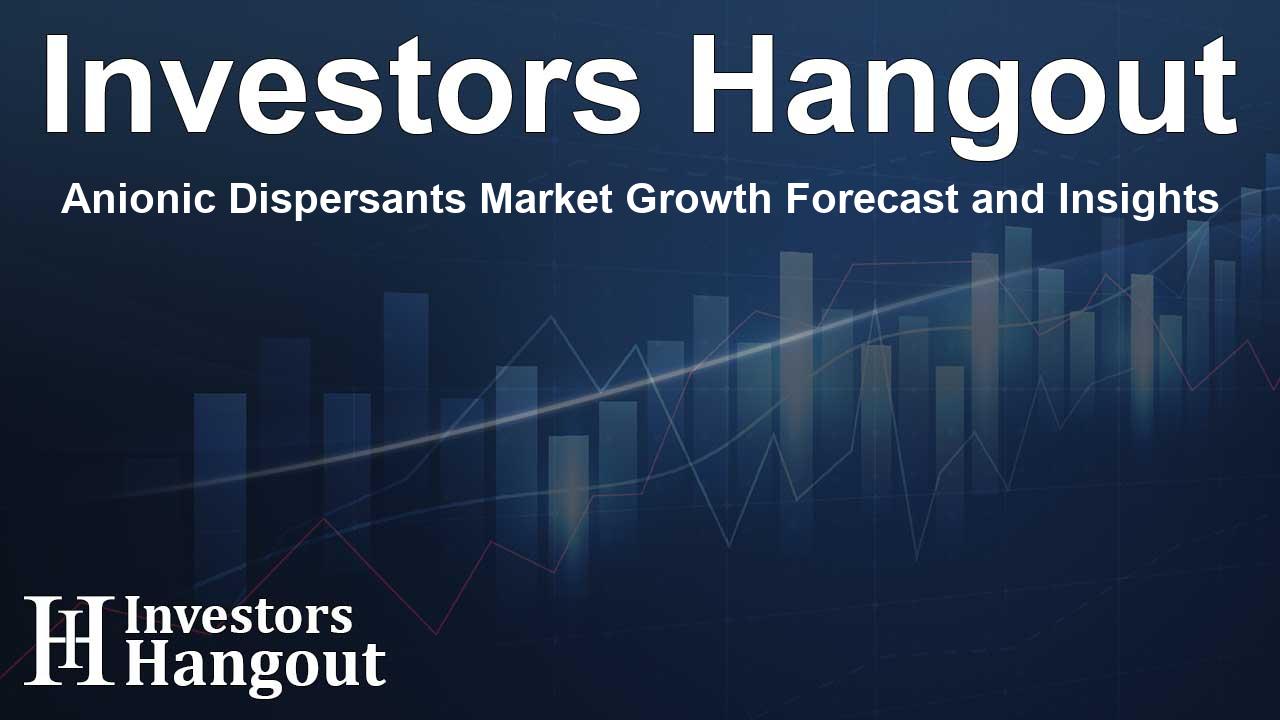Anionic Dispersants Market Growth Forecast and Insights

Overview of the Anionic Dispersants Market
The anionic dispersants market is making significant strides, with an estimated valuation set to grow impressively over the coming years. The market is projected to achieve a remarkable valuation of US$ 750.0 million by the year 2034, expanding at a CAGR of 4.4% from its current base. This growth is primarily fueled by an escalating demand across a variety of industries including construction, agriculture, and consumer goods.
Drivers of Growth in the Anionic Dispersants Market
Several factors are propelling the expansion of the anionic dispersants market. The construction industry is poised to be a primary driver. As nations invest in infrastructure development, there’s an increasing requirement for quality construction materials. Anionic dispersants play a critical role in enhancing the workability and strength of concrete, thus contributing significantly to successful infrastructure projects globally.
Another pivotal sector contributing to this growth is the paints and coatings industry. The shift towards eco-friendly water-based products, spurred by stringent environmental regulations and changing consumer preferences, positions anionic dispersants as vital components in achieving high-performance formulations. Their effectiveness in maintaining stability and performance makes them indispensable in various paint and coating applications.
Market Insights and Key Takeaways
The market study reveals intriguing insights for stakeholders. The anionic dispersants market is estimated to have generated an opportunity of approximately US$ 262.1 million between 2024 and 2034. Furthermore, East Asia is expected to emerge as a stronghold, possibly capturing 24.8% of the market share in 2024. Moreover, the printing and packaging sector within the anionic dispersants type segment is projected to grow at a 4.0% CAGR, creating an absolute dollar opportunity of US$ 13.9 million in the same timeframe.
Interestingly, North America and East Asia together are forecasted to generate an absolute opportunity exceeding US$ 129.8 million, reflecting the global nature of this market's growth.
Challenges and Considerations
While growth prospects appear promising, companies in the anionic dispersants market must navigate challenges associated with regulatory changes and competition among manufacturers. Innovation through research and development is key to staying ahead, as companies seek to enhance their product offerings to satisfy evolving consumer demands.
Key Players in the Anionic Dispersants Market
A spotlight on leading companies reveals players such as BASF, Arkema, Ashland, Nouryon, Mapei, and Clariant, who are heavily investing in research and development. Their aim is to innovate and cater to specific industry needs, ensuring they maintain a competitive edge and garner customer loyalty.
Recent Developments in the Market
- Recently, BASF announced the expansion of its capacity to manufacture water-soluble dispersants at its facility in Turkey, aimed at meeting growing demand from the cleaning and detergent sectors.
- Arkema has unveiled advancements in its technology portfolio, enhancing its position in the development of sustainable battery materials.
- Nippon Shokubai showcased a groundbreaking desalinization plant utilizing its new material in Hawaii, emphasizing its commitment to innovative solutions for sustainable practices.
Conclusion
The anionic dispersants market is positioned for transformative growth, with demand soaring across multiple industries. Factors such as environmental legislation, consumer behavior changes, and robust infrastructure projects are steering the trajectory of this market. Companies focusing on innovative solutions and sustainable practices will be pivotal in shaping the future landscape of the anionic dispersants industry.
Frequently Asked Questions
What is the projected growth of the anionic dispersants market?
The market is expected to grow at a CAGR of 4.4% and reach US$ 750.0 million by 2034.
Which industries are driving the demand for anionic dispersants?
The key industries include construction, agriculture, and paints and coatings, with construction being a significant factor in recent growth.
Who are the key players in the anionic dispersants market?
Leading companies include BASF, Arkema, Ashland, Nouryon, and Clariant, among others.
How do anionic dispersants impact construction projects?
Anionic dispersants enhance the workability and strength of concrete, making them essential for successful infrastructure development.
What recent developments have been seen in the anionic dispersants sector?
Recent advancements include capacity expansions by BASF and technology developments by Arkema and Nippon Shokubai to enhance sustainability.
About Investors Hangout
Investors Hangout is a leading online stock forum for financial discussion and learning, offering a wide range of free tools and resources. It draws in traders of all levels, who exchange market knowledge, investigate trading tactics, and keep an eye on industry developments in real time. Featuring financial articles, stock message boards, quotes, charts, company profiles, and live news updates. Through cooperative learning and a wealth of informational resources, it helps users from novices creating their first portfolios to experts honing their techniques. Join Investors Hangout today: https://investorshangout.com/
Disclaimer: The content of this article is solely for general informational purposes only; it does not represent legal, financial, or investment advice. Investors Hangout does not offer financial advice; the author is not a licensed financial advisor. Consult a qualified advisor before making any financial or investment decisions based on this article. The author's interpretation of publicly available data shapes the opinions presented here; as a result, they should not be taken as advice to purchase, sell, or hold any securities mentioned or any other investments. The author does not guarantee the accuracy, completeness, or timeliness of any material, providing it "as is." Information and market conditions may change; past performance is not indicative of future outcomes. If any of the material offered here is inaccurate, please contact us for corrections.